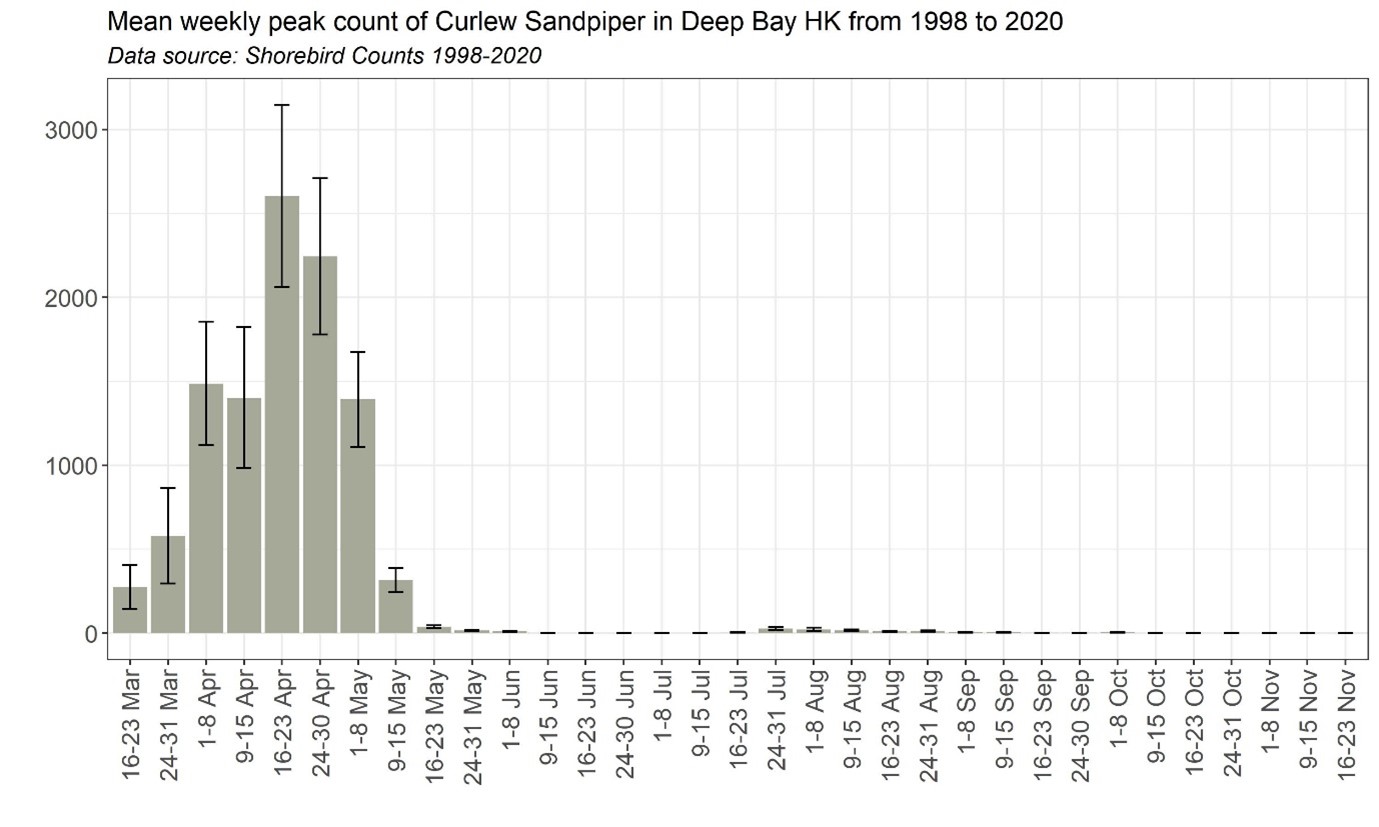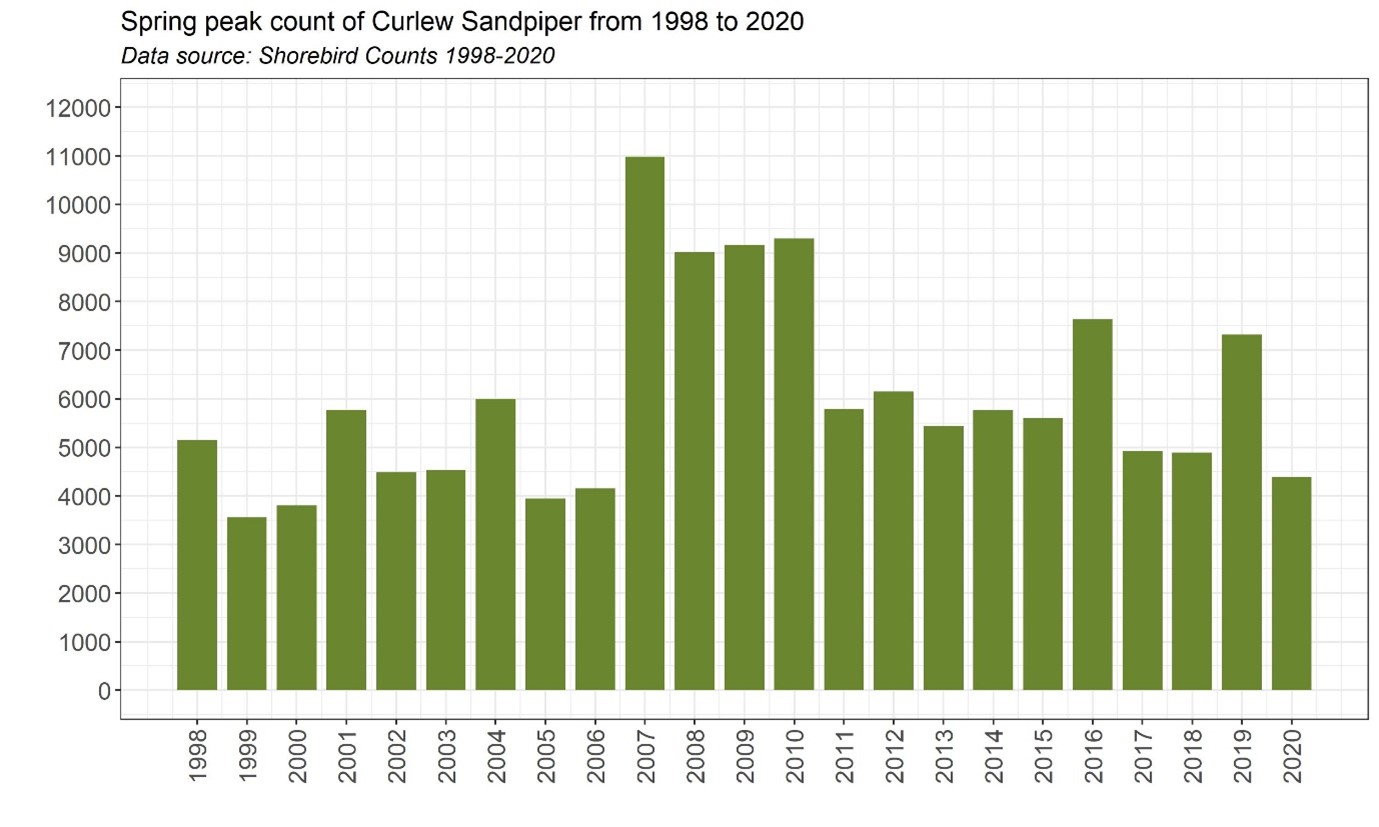Curlew Sandpiper Calidris ferruginea 彎嘴濱鷸
Category I. Abundant spring migrant, scarce autumn migrant and rare winter visitor to Deep Bay area.
IDENTIFICATION

Apr. 2009, Martin Hale. Breeding plumage. Probably male based on short bill.
18-23 cm. Slightly larger and more elegant than Dunlin with longer legs and longer, more finely-tipped decurved bill. Adult breeding rusty-brown below with large orange areas in scapulars and white on the fore part of the face and supercilium.

Apr. 2006, Martin Hale. Non-breeding plumage.
Birds in winter plumage are slightly paler than Dunlin and have a more pronounced supercilium, a longer, more finely-tipped bill and longer legs.

Sep. 2005, John and Jemi Holmes. Juvenile.
Juvenile has buff washed breast that is lightly streaked at the side and uniformly pale-fringed upperpart feathers with dark subterminal area and shaft.

Apr. 2020, John and Jemi Holmes.
In flight the white rump is usually distinctive, though on many adults there are a few darker feathers and on a small number there can be a line of dark feathers down the centre of the rump. Juveniles tend to have pure white rumps (D. N. Bakewell in litt.).
VOCALISATIONS
The typical flight call is fairly high-pitched and trilling.
DISTRIBUTION & HABITAT PREFERENCE
Most records are from the Deep Bay area where birds feed on the intertidal mudflats of the bay and roost inland, usually at Mai Po NR. Up to 32 birds have been recorded on drained fish ponds.
The highest counts away from the Deep Bay area involve birds on migration over the sea in spring, including up to 55 off Cape D’Aguilar during a tropical storm, up to 50 off Po Toi and 25 in Mirs Bay. Spring records are from widespread sites mainly during spring passage, with all involving nine birds or fewer apart from one record of 14 at Kai Tak.
OCCURRENCE
Curlew Sandpiper is the most abundant migrant shorebird passing through in spring with four-figure totals present on most days in April and the first week of May. Migrants can be present as early as the last week of February, and though in general the first birds occur during the second week of March, as many as 2,080 have been recorded as early as 21 March. As Figure 1 indicates, main passage occurs from the first week of April to the first week of May, peaking in the second half of April; the highest count is 10,982 on 17 April 2007. By the middle of May very few birds remain, and the latest three-figure count in that month is on the 23rd.
This century Curlew Sandpiper has been recorded in June and early July in ones or twos in approximately 50% of years, the highest count at this time being 14. However, the highest summer count is of up to 80 birds in 1992.
Return passage is noted in the second half of July, though the numbers passing through in autumn are but a fraction of those in spring, indicating a different strategy from that taken on northward migration. Curlew Sandpipers are known to be able to fly non-stop from the eastern seaboard of China to Australia (Barter and Wang 1990), and this might explain the relative dearth of autumn records in HK.
The highest autumn counts are 379 on 1 August 1993 and 356 on 7 August 1994, with the highest this century being 239 on 23 July 2007. The main period of autumn passage occurs during August, and from October single-figure counts are usually made. Wintering birds are rare and only one or two birds are seen, with the highest count being three.
During autumn adults have occurred from 23 July to 27 October, and juveniles have been reported from 1 August to 23 October. Up to at least early September, most birds are adults, with juveniles predominating subsequently. However, over the autumn passage period as a whole, most birds are adults. Thus, only two of the 379 recorded on 1 August 1993 (the highest autumn count) were juveniles; the highest count of juveniles is ten on 23 October 1994.
The years 2007-10 saw very high numbers recorded, with peak counts over 9,000 (Figure 2). In addition, there has been a recent tendency for very high numbers to be present as early as the last week of March, with counts of over 2,000 occurring in seven years during 2010-20, including counts of over 5,000 in three years (the highest being 5,794 in 2011). The highest count in the same period in the 1990s was 1,000 (albeit there were no systematic shorebird counts before 1998).
Curlew Sandpiper was first recorded in HK on 5 October 1930 by Hutson (1930). Subsequently, Dove and Goodhart (1955) had two April records and Macfarlane and Macdonald (1966) reported up to 30 birds from 28 March to 30 May and 7 July to 5 October, with the highest numbers in spring. It was only with improved access to Deep Bay did the true abundance of this species become apparent.
BEHAVIOUR, FORAGING & DIET
Large flocks forage intensely on the intertidal mudflats on spring passage. Picks prey from surface of mud or inserts bill a short way.
RANGE & SYSTEMATICS
Monotypic. Breeds north of the Arctic Circle in Siberia from the Yamal Peninsula east to the northern part of the Chukotka peninsula; winters from sub-Saharan Africa through the Middle East to south and southeast Asia and Australasia (Van Gils et al. 2020). In China a migrant through much of the country and a winter visitor to the southeast coast, including Hainan and Taiwan (Liu and Chen 2020).
CONSERVATION STATUS
IUCN: VULNERABLE. Population trend decreasing by 30-49% over three generations. The population using the East Asian – Australasian Flyway is thought to be experiencing severe decline due to habitat loss in the Yellow Sea.
Figure 1.

Figure 2.

Dove, R. S. and H. J. Goodhart (1955). Field observations from the Colony of Hong Kong. Ibis 97: 311-340.
Hutson, H. P. W. (1930). Notes and comments. Ornithology. Hong Kong Naturalist 1: 190-193.
Macfarlane, A. M. and A. D. Macdonald, revised by Caunter, J. R. L. and A. M. Macfarlane (1966). An Annotated Check-list of the Birds of Hong Kong. Hong Kong Bird Watching Society, Hong Kong.
Van Gils, J., P. Wiersma, G. M. Kirwan, and C. J. Sharpe (2020). Curlew Sandpiper (Calidris ferruginea), version 1.0. In Birds of the World (J. del Hoyo, A. Elliott, J. Sargatal, D. A. Christie, and E. de Juana, Editors). Cornell Lab of Ornithology, Ithaca, NY, USA. https://doi.org/10.2173/bow.cursan.01
Liu, Y. and Y. H. Chen (eds) (2020). The CNG Field Guide to the Birds of China (in Chinese). Hunan Science and Technology Publication House, Changsha.

